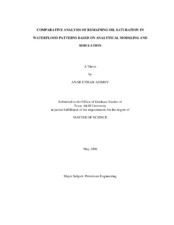| dc.description.abstract | In assessing the economic viability of a waterflood project, a key parameter is the
remaining oil saturation (ROS) within each pattern unit. This information helps in
identifying the areas with the highest ROS and thus potential for further development.
While special core analysis, log-inject-log, and thermal-decay time-log-evaluation
techniques are available, they provide only single-point values and a snapshot in time
near a wellbore. Also, they can quickly add up to an expensive program.
The analytical areal distribution method estimates ROS in a waterflood pattern unit from
material balance calculations using well injection and production data with no pressure
information required. Well production and injection volumes are routinely measured in
oilfield operations, making the method very attractive.
The areal distribution technique estimates two major uncertainties: vertical loss of
injected water into nontarget areas or areal loss into surrounding patterns, and injected
water for gas fill-up. However, developers tested it only in low-pressure conditions,
which are increasingly rare in oilfield operations. The main purpose of my research, then, was to verify whether or not the areal
distribution method is valid in higher pressure conditions. Simulation of various
waterflood patterns confirmed that the areal distribution method with its estimated ROS
is capable of precise estimation of actual ROS, but at high pressures it requires
consideration of pressure data in addition to injection and production data. | en |


